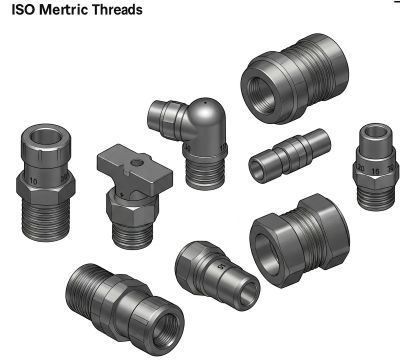ISO metric threads are a standardized system of screw threads widely used in engineering and manufacturing. These threads follow the International Organization for Standardization (ISO) specifications to ensure compatibility across different industries and applications.
Standardized threads play a crucial role in ensuring the interchangeability of components, reducing production costs, and improving reliability. The ISO metric thread system allows manufacturers worldwide to use a common threading standard, making assembly and maintenance more efficient.
This article aims to provide a comprehensive understanding of ISO metric thread standards, tolerances, and applications. By the end, readers will have a clear grasp of how these threads function and why they are vital in various industries.
What Are ISO Metric Threads?
ISO metric threads are screw threads that conform to the ISO standard, typically denoted by an “M” followed by the nominal diameter in millimeters (e.g., M10). They provide a globally recognized system for fasteners, ensuring consistency and reliability.
The ISO metric thread system was developed to standardize screw threads internationally. It gradually replaced older national threading systems, such as the Whitworth and Unified threads, becoming the most commonly used thread system worldwide.
Difference Between Metric and Imperial Thread Systems
➡️ Metric Threads: Measured in millimeters, with pitch defined as the distance between threads.
➡️ Imperial Threads: Measured in inches, with pitch defined in threads per inch (TPI).
Metric threads offer greater precision and standardization, while imperial threads are still common in the U.S. and some older machinery.
ISO Metric Thread Standards
ISO 68-1 (Basic Profile)
ISO 68-1 defines the fundamental profile of ISO metric threads, establishing the basic dimensions and geometry that ensure proper function and compatibility.
ISO 261 (General Purpose Metric Threads)
ISO 261 specifies standard thread sizes and pitches for general applications, ensuring widespread compatibility across industries.
ISO 965 (Tolerances and Deviations)
ISO 965 outlines the permissible deviations for metric threads, defining fit classes and tolerances for different applications.
Explanation of Thread Designation (e.g., M10 × 1.5)
➡️ M10 – Nominal diameter (10 mm)
➡️ 1.5 – Pitch (1.5 mm between threads)
➡️ Additional letters may indicate tolerance grades and fit classes.
Metric Thread Sizes and Pitch
Explanation of Major, Minor, and Pitch Diameters
➡️ Major Diameter: The largest diameter of the thread.
➡️ Minor Diameter: The smallest diameter of the thread.
➡️ Pitch Diameter: The average diameter between the major and minor diameters.
Coarse vs. Fine Thread Pitches
➡️ Coarse Threads: Larger pitch, stronger but less resistant to loosening.
➡️ Fine Threads: Smaller pitch, better for precision applications.
Commonly Used Metric Thread Sizes
Popular sizes include M3, M6, M10, M12, and M20, used in various industries for different applications.
Tolerances and Fit Classes
Explanation of Tolerance Grades (e.g., 6g, 6H)
Tolerance grades define the allowable variation in thread dimensions, with numbers indicating size deviation and letters specifying internal (H) or external (g) threads.
Differences Between Internal and External Thread Fits
➡️ Internal (Female) Threads: Designated by H (e.g., 6H).
➡️ External (Male) Threads: Designated by g (e.g., 6g).
Application of Different Fit Classes in Manufacturing
Different fits ensure proper assembly based on the level of precision required, such as loose fits for general use or tight fits for high-precision applications.
Thread Manufacturing and Inspection
Common Manufacturing Methods
➡️ Cutting: Using taps, dies, or lathes.
➡️ Rolling: A deformation process that strengthens threads.
Tools Used for Measuring Thread Dimensions
➡️ Thread gauges
➡️ Micrometers
➡️ Optical comparators
Quality Control and Tolerance Verification
Precision measurement and testing ensure threads meet ISO standards, preventing assembly issues.
Common Applications of ISO Metric Threads
Automotive Industry
Used in engine components, fasteners, and suspension systems.
Aerospace and Engineering
Critical for aircraft structures and mechanical assemblies requiring precision.
Construction and Fasteners
Essential for bolts, screws, and anchors in structural projects.
Machinery and Equipment
Integral to the assembly of industrial machines and manufacturing tools.
Advantages and Limitations of ISO Metric Threads
Benefits of Using Metric Threads Over Imperial Threads
➡️ Global standardization
➡️ Greater precision
➡️ Simplified calculations
➡️ Easier interchangeability
Challenges in Conversion and Standardization
➡️ Some industries still use imperial threads, requiring adapters.
➡️ Older machinery may not be compatible with metric threads.
Conclusion
ISO metric threads provide a globally accepted standard for fasteners, ensuring compatibility, precision, and efficiency in engineering and manufacturing.
A proper understanding of metric threads helps in selecting the right fasteners for various applications, improving product reliability and performance.
For engineers and manufacturers, adopting ISO metric threads ensures compliance with international standards, leading to better design consistency and efficiency in global trade.
Post time: Apr-11-2025


